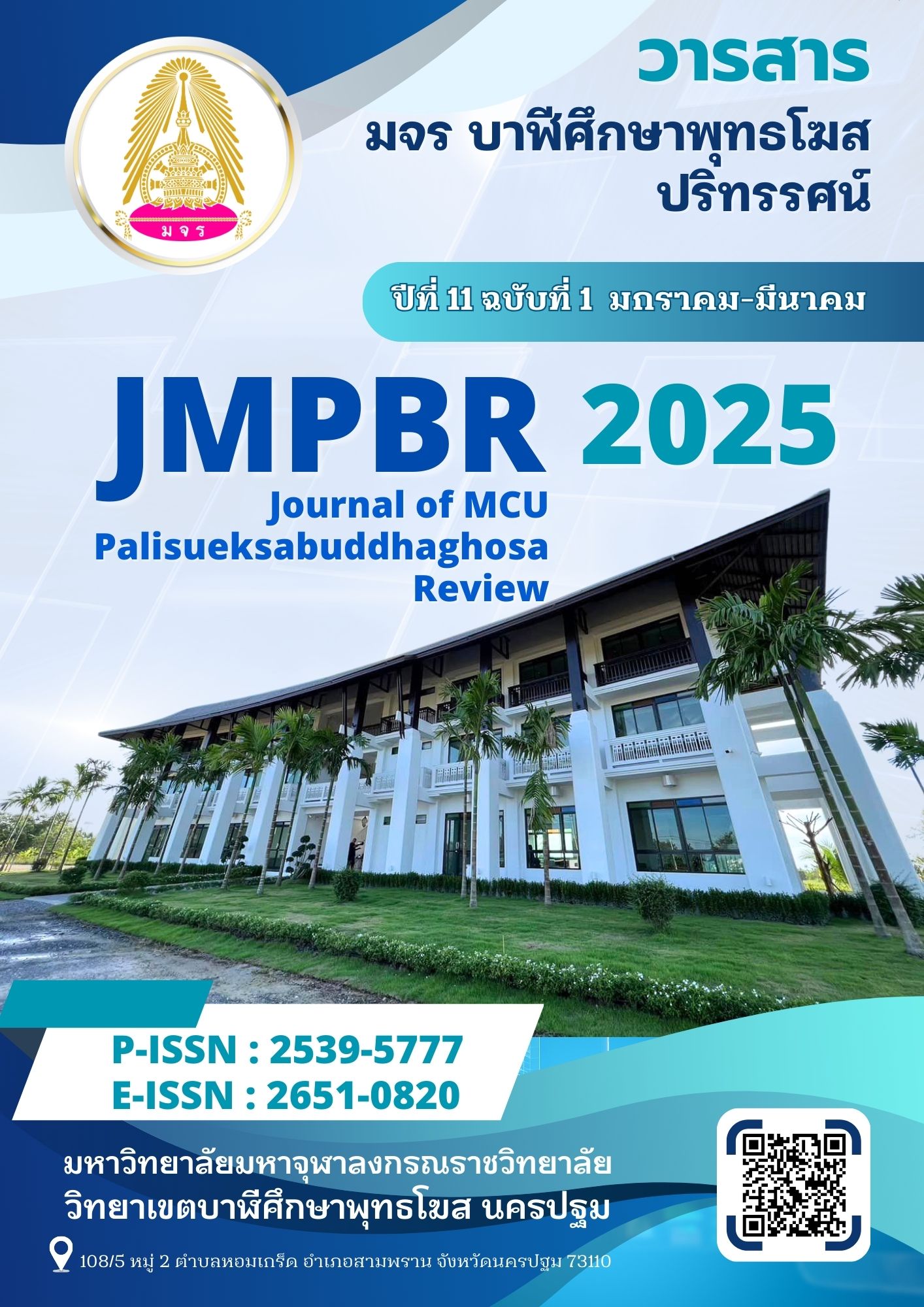The Model of Meditation Center Development Based on Seven Sappaya Principle of Wat Huaicharoen, Sriprachan District, Suphanburi Province
Main Article Content
Abstract
This dissertation investigated on 3 objectives: 1) to study the 7 Sappāya principles in Theravada Buddhist scriptures, 2) to study the conditions of Wat Huaicharoen Meditation Center, Sriprachan district, Suphanburi province, and 3) to the Model of Meditation Center Development Based on Seven Sappaya Principle of Wat Huaicharoen, Sriprachan District, Suphanburi Province. It was qualitative research with fieldwork and in-depth interviews conducted with 17 key informants.
Its findings indicated that the Sappāya refers to the conducive conditions that foster progress in meditation practice, consisting of seven aspects: (1) suitable residence, (2) suitable resort, (3) suitable conversation, (4) suitable person, (5) suitable food, (6) suitable climate, and (7) suitable posture. These conditions are comfortable and fit for meditation practice, including both Samatha and Vipassana. Wat Huaicharoen Meditation Center has developed both the accommodations and the surrounding area. It is shaded by trees and forests, clean, and suitable for moral training and mental development according to the teachings and meditation practice as laid down by the Buddha, following the Seven Sappāya principle. The development of Wat Huaicharoen Meditation Center, Sriprachan district, Suphanburi province based on 7 Sappāya principle, involves solving problems and obstacles using these principles and reviewing previous development work under the PDCA process for planning, operations and promotion of Vipassana meditation practice applying 7 Sappāya principles for its effective duties and works of each person and authority, by identifying the responsible person, duties and schedule time for process, documents which are proper with environment, and the needs of the Wat’s committees, it also supports, prevents, solves, renovates rightly, which can resolve conflicts and issues regarding works among the staffs within the temple. When applying these principles, it will create benefits and foster supportive conditions for insight meditators. The knowledge gained was 7SMC model: 7S = Seven Sappāya, M = Meditation (Vipassana meditation practice based on Mahasatipatthana), C = Center (Meditation Center developed according to 7 Sappāya principle).
Article Details

This work is licensed under a Creative Commons Attribution-NonCommercial-NoDerivatives 4.0 International License.
Copyright Notice
The content and information in the articles published in Journal of MCU Palisueksabuddhaghosa Review, are regarded as opinions and responsibilities of article author only. It definitely does not mean that the editor must agree or share any responsibility to the author.
Articles, information, content, figure etc. that have been published in the Journal of MCU Palisueksabuddhaghosa Review is considered as the copyright of the Journal. If any individual or organization will to bring any parts of article for promote or to do anything, must be licensed only in official form from the Journal of MCU Palisueksabuddhaghosa Review.
The content and information in the articles published in Journal of MCU Palisueksabuddhaghosa Review, are regarded as opinions and responsibilities of article author only. It definitely does not mean that the editor must agree or share any responsibility to the author.
Articles, information, content, figure etc. that have been published in the Journal of MCU Palisueksabuddhaghosa Review is considered as the copyright of the Journal. If any individual or organization will to bring any parts of article for promote or to do anything, must be licensed only in official form from the Journal of MCU Palisueksabuddhaghosa Review.
References
มหาจุฬาลงกรณราชวิทยาลัย. (2539). พระไตรปิฎกภาษาไทย ฉบับมหาจุฬาลงกรณราชวิทยาลัย. กรุงเทพมหานคร: โรงพิมพ์มหาจุฬาลงกรณราชวิทยาลัย.
พระมหาวิเชียร ชาญณรงค์. (2547). “บทบาทพระสงฆ์ในการนาหลักธรรมมาใช้ทากิจกรรมงานพัฒนาชุมชน เพื่อ ลด ละ เลิก อบายมุข: ศึกษาเฉพาะกรณีพระครูศีลาวราภรณ์”. วิทยานิพนธ์ศิลปศาสตรมหาบัณฑิต. บัณฑิตวิทยาลัย:มหาวิทยาลัยธรรมศาสตร์.
พระมหาบุญมี อธิปุญฺโญ. (2544). “บทบาทของพระสังฆาธิการพัฒนาสังคม: ศึกษากรณีพระธรรมวิสุทธิมงคล (บัว ญาณสมฺปนฺโน)”. วิทยานิพนธ์ศาสนศาสตรมหาบัณฑิต. บัณฑิตวิทยาลัย: มหาวิทยาลัยมหามกุฏราชวิทยาลัย.
พระมหาสุภา อุทฺโท. (2541). “บทบาทของพระสงฆ์ต่อสังคมไทยใน 2 ทศวรรษหน้า”. วิทยานิพนธ์สังคมสงเคราะห์ศาสตรมหาบัณฑิต. บัณฑิตวิทยาลัย: มหาวิทยาลัยธรรมศาสตร์.
พระมหาอนันต์ ดอนนอก. (2540). “บทบาทของพระสงฆ์ในการพัฒนาชุมชนตามโครงการอบรมประชาชนประจาตำบล ในจังหวัดนครราชสีมา”. วิทยานิพนธ์สังคมสงเคราะห์ศาสตรมหาบัณฑิต. บัณฑิตวิทยาลัย: มหาวิทยาลัยธรรมศาสตร์.
สุทธิพงศ์ ตันตยาพิศาลสุทธิ์. (2541). พระราชบัญญัติคณะสงฆ์ กฎกระทรวง กฎมหาเถรสมาคม พร้อมด้วยระเบียบและคำสั่งมหาเถรสมาคมที่เกี่ยวกับการคณะสงฆ์และการพระศาสนา. กรุงเทพมหานคร: โรงพิมพ์ กรมการศาสนา,
สำนักงานพระพุทธศาสนาแห่งชาติ. ข้อมูลวัดและพระสงฆ์ 2553. [ออนไลน์]. แหล่งที่มา: http://www.onab.go.th/ [31 สิงหาคม 2565].
สำนักงานสถิติแห่งชาติ. จำนวนประชากร 2553. [ออนไลน์]. แหล่งที่มา: http://www.nso. go.th/ [31 สิงหาคม 2565].

